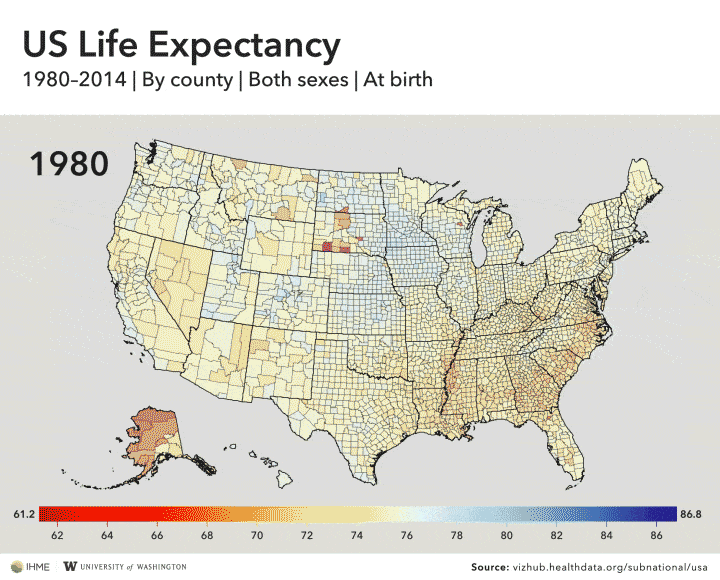If you live in central Colorado, chances are you’ll live longer than any other American. That’s good news for Coloradans but not so much for everyone else as a recent study found the difference in life expectancy between U.S. counties can vary wildly. In some cases, life expectancy at birth differs by as much as 20 years between the lowest and highest United States counties.

The team led by Dr. Christopher J.L. Murray, who is the director of the Institute for Health Metrics and Evaluation at the University of Washington, found that life expectancy in the United States is on the rise. Between 1980 and 2014, men gained 6.7 years, from 70 years on average to 76.7 years, while women gained four years, from 77.5 years to 81.5 years.
When the researchers zoomed in on the data on a county by county, they found life expectancy varied a lot. The lowest life expectancy was found to be in South and North Dakota, particularly in Native American reservations which uncoincidentally are some of the poorest regions in the nation. Other counties that showed very low life expectancies, some below 60 years, include some in the lower half of Mississippi, eastern Kentucky, and southwestern West Virginia.
On the opposite end, Summit County in Colorado ranked the highest in terms of life expectancy which sat at 86.8 years in 2014. Summit County has a population of 27,994 and is home to several ski resort towns which might explain why residents’ longevity. Summit County also had almost no lung cancer mortality — a death rate of only 11 per 100,000 population in 2014, as reported in a previous study performed by the same research center.

There are a couple of factors that influence life expectancy but “60% of the differences in life expectancy across counties can be explained by socioeconomic factors alone,” the researchers noted in the journal JAMA Internal Medicine. The rest can be explained by health and risk factors like smoking, physical activity, obesity, diabetes, and so on.
Yet despite the huge gap between some counties, the bottom line is that, overall, most of them have improved their life expectancy. Counties in Colorado, Alaska and along both coasts experienced the largest increases while, conversely, counties in Oklahoma or West Virginia experienced either no or little improvement since 1980.
At the same time, let’s not forget the United States is the most powerful country in the world and any comparison needs to be made alongside its peers. In this key regard, however, the United States seems to lag behind significantly. Ali Mokdad, a co-author of the report, said the US is falling behind competitors in terms of health and this will “impact our productivity; that’s going to take away our competitive edge when it comes to the economy.” Mokdad specifically alluded to poor policy and action in terms of tackling preventable risk factors such as smoking, obesity or high blood pressure.
“The inequality in health in the United States — a country that spends more on health care than any other — is unacceptable,” said Murray. “Every American, regardless of where they live or their background, deserves to live a long and healthy life.”


